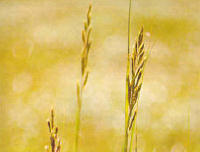 |
The spikeletsWhen the first heat arrives, all grasses ripen, and their spikelets dry and detach to ensure the plant's reproduction. |
The spikelets adhere to the plant so that they can be transported far and wide in the fur of animals.
Unfortunately, they can penetrate natural orifices and even the skin.
In the ear, they cause the animal to complain more or less loudly, shaking its head. Pain only occurs when the spike reaches the “cul-de-sac” of the auditory canal, and is therefore invisible. Extraction can only be performed with an otoscope and Hartmann forceps (with or without narco-analgesia, depending on the case).
In the eye, there is a violent inflammatory reaction with blepharospasm. Extraction is performed under local or general anaesthetic. The consequences are usually benign.
Between the fingers, a more or less large abscess is formed, usually with mild pain. Extraction is more or less delicate, as the search for the foreign body may require anaesthesia and a relatively large incision.
In the nose, it causes violent, repetitive sneezing and sometimes epistaxis (bleeding). Removal requires deep anesthesia to suppress the sneezing reflex, so that the entire nasal turbinates can be explored. If the procedure is not performed, chronic rhinitis will develop, or the spikelet will at best be swallowed, or at worst travel up the lacrimal duct into an eye, which is very traumatic.
In the sheath or lips of the vulva; under the skin: formation of abscesses of varying size.
The problem of urgency is linked to the pain suffered by the animal, and not to the risk of death. Each case must be considered according to the location of the foreign body, the intensity of the pain and the sensitivity of the owner.







 English (United Kingdom)
English (United Kingdom)